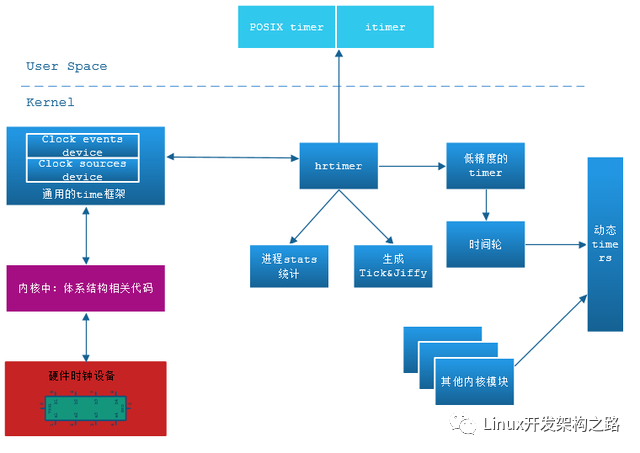Linux內核定時器
在Linux內核中,也可以通過定時器來完成定時功能。但和單片機不同的是,Linux內核定時器是一種基于未來時間點的計時方式,它以當前時刻為啟動的時間點,以未來的某一時刻為終止點,類似于我們的鬧鐘。
當內核定時器定時時間到達時,會進入用戶指定的函數,相當于軟中斷。內核定時器完成注冊啟動后,僅執行一次后就不會重復執行(即超時候會自動關閉),若需要重復執行則需要手動再次啟動(即修改超時時間)。
Linux內核定時器相關函數位置:include/linux/timer.h
1.相關結構體
??在使用內核定時器時,我們需要關心的相關結構體及其成員:
struct timer_list {
struct list_head entry;
unsigned long expires; /* 定時器時鐘節拍*/
struct tvec_base *base;
void (*function)(unsigned long); /*定時器工作函數 */
unsigned long data; /*傳給定時器工作函數的參數 */
};
?在Linux內核中,有一個全局變量jiffies用來記錄時鐘節拍,每當時鐘中斷觸發一次,jiffies就會+1。因此jiffies變量記錄了系統從啟動開始時鐘中斷觸發的次數。我們由此可以利用jiffies來計算驅動程序運行時長。jiffies每秒增加HZ次,因此jiffies+1的時長有HZ決定。當HZ=100時,jiffies+1的時長則為10ms。在Linux3.5的內核中HZ值默認為200,即jiffies+1的時長則為5ms。

2.相關函數
2.1 定時器初始化init_timer()
#define init_timer(timer)
函數功能: 初始化定時
形參: 定時器結構體
2.2 啟動定時器add_timer()
void add_timer(struct timer_list *timer)
函數功能: 啟動定時器
形參: 定時器結構體
2.3 修改定時時間mod_timer()
int mod_timer(struct timer_list *timer, unsigned long expires)
函數功能: 修改定時器時間
形參: timer – 定時器結構體
???expires --定時時間( 以時鐘節拍填入)
??注意:expires 填寫是基于jiffies+延時時間
2.4毫秒轉為時鐘節拍 msecs_to_jiffies()
unsigned long msecs_to_jiffies(const unsigned int m)
函數功能: 將毫秒時間轉換為時鐘節拍數
形參: m – 毫秒時間
返回值: – 返回節拍數
2.5微秒轉為時鐘節拍 usecs_to_jiffies()
unsigned long usecs_to_jiffies(const unsigned int u)
函數功能: 將微秒時間轉換為時鐘節拍數
形參: m – 位秒時間
返回值: – 返回節拍數
2.6關閉定時器
int del_timer(struct timer_list *timer)
函數功能:關閉定時器(停用一個定時器)
define del_timer_sync(t)
函數功能:關閉定時器(停用一個定時器),多處理器使用。如果編內核時不支持 SMP(多處理器), del_timer_sync()和 del_timer()等價
2.7 獲取jiffies時間
#include
u64 get_jiffies_64(void)
函數功能: 獲取jiffies時間
返回值: 返回時鐘節拍jiffies
2.8 獲取內核高精度時間
ktime_t ktime_get(void)
函數功能: 獲取內核高精度時間
返回值: ktime_t – 共用體類型
union ktime {
s64 tv64;
#if BITS_PER_LONG != 64 && !defined(CONFIG_KTIME_SCALAR)
struct
{
# ifdef __BIG_ENDIAN
s32 sec, nsec;
# else
s32 nsec, sec;
# endif
} tv;
#endif
};
2.9 時間轉換函數
s64 ktime_to_ms(const ktime_t kt) /* 將獲取的系統時鐘轉換為ms單位*/
s64 ktime_to_us(const ktime_t kt) /* 將獲取的系統時鐘轉換為us單位*/
/將獲取的時間轉換為時鐘結構體/
struct timeval ktime_to_timeval(const ktime_t kt)
struct timespec ktime_to_timespec(const ktime_t kt)
3.內核定時器示例
??內核定時器使用步驟:
- 初始化內核定時器init_timer,設置超時時間,編寫內核定時工作函數;
- 啟動定時器add_timer;
- 若需要重復定時,則需要在定時器工作函數中修改超時時間mod_timer
#include
#include
#include
#include
#include
struct timer_list timer;
/*定時器工作函數*/
void timer_work(unsigned long data)
{
ktime_t time1;
printk("定時器時間到!data=%ld,",data);
time1=ktime_get();
printk("定時時間:%llu \n",ktime_to_ms(time1));
mod_timer(&timer,jiffies+msecs_to_jiffies(2000));/*修改定時時間*/
}
static int __init wbyq_timer_init(void)
{
timer.expires=jiffies+msecs_to_jiffies(1000);/*定時時間*/
timer.function=timer_work;/*定時器工作函數*/
timer.data=666;/*傳給定時器工作函數參數,選填*/
init_timer(&timer);/*初始化定時器*/
add_timer(&timer);/*啟動定時器*/
return 0;
}
/*驅動釋放*/
static void __exit wbyq_timer_cleanup(void)
{
del_timer_sync(&timer);//關閉定時器
printk("驅動出口,驅動注銷成功\n");
}
module_init(wbyq_timer_init);//驅動入口函數
module_exit(wbyq_timer_cleanup);//驅動出口函數
MODULE_LICENSE("GPL");//驅動注冊協議
MODULE_AUTHOR("it_ashui");
MODULE_DESCRIPTION("Exynos4 timer Driver");

審核編輯:湯梓紅
-
內核
+關注
關注
3文章
1372瀏覽量
40277 -
Linux
+關注
關注
87文章
11292瀏覽量
209328 -
定時器
+關注
關注
23文章
3246瀏覽量
114719
發布評論請先 登錄
相關推薦
Linux驅動開發-內核定時器
芯靈思SinlinxA33開發板Linux內核定時器編程
「正點原子Linux連載」第五十章Linux內核定時器實驗
「正點原子Linux連載」第五十章Linux內核定時器實驗
【正點原子FPGA連載】第三十二章Linux內核定時器實驗-領航者ZYNQ之linux開發指南
ARM Cortex-M0+內核定時器
Linux內核定時器的相關資料分享
Win32s下內核定時器的使用
LINUX內核定時器(高精度&低精度)
Linux內核定時器的詳細資料概述

慕課嵌入式開發及應用(第三章.ARM Cortex-M0+內核定時器 (Systic)





 Linux內核定時器
Linux內核定時器











評論